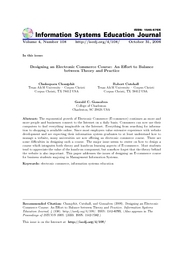Volume 4
Volume 4, Number 108 |
October 31, 2006 |
Abstract: The exponential growth of Electronic Commerce (E-commerce) continues as more and more people and businesses connect to the Internet on a daily basis. Consumers can now use their computers to find everything imaginable on the Internet. Everything from searching for information to shopping is available online. Since most employers value extensive experience with website development and are expecting their information system graduates to at least understand how to manage a website, many universities are now offering an electronic commerce course. There are some difficulties in designing such a course. The major issue seems to center on how to design a course which integrates both theory and hands-on learning aspects of E-commerce. Most students tend to appreciate the value of the hands-on component, but somehow forget that the theory behind the website is also important. This paper addresses the issues of designing an E-commerce course for business students majoring in Management Information Systems.
Keywords: electronic commerce, information systems education
Download this issue: ISEDJ.4(108).Changchit.pdf (Adobe PDF, 7 pages, 371 K bytes)
Preview the contents: Changchit.j.txt (ASCII txt, 16 K bytes)
Recommended Citation: Changchit, Cutshall, and Gonsalves (2006). Designing an Electronic Commerce Course: An Effort to Balance between Theory and Practice. Information Systems Education Journal, 4 (108). http://isedj.org/4/108/. ISSN: 1545-679X. (A preliminary version appears in The Proceedings of ISECON 2005: §3333. ISSN: 1542-7382.)
